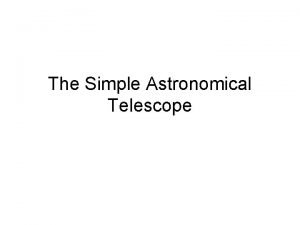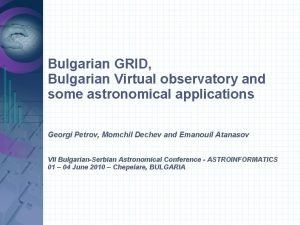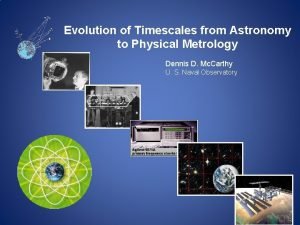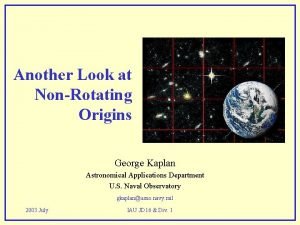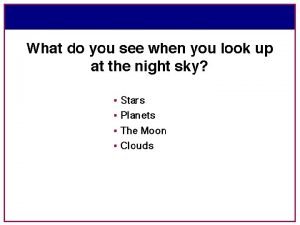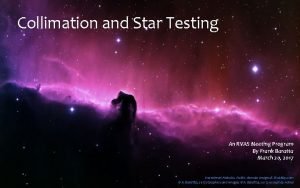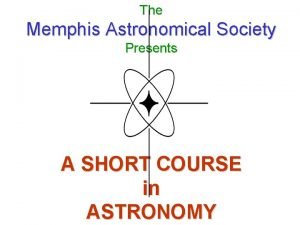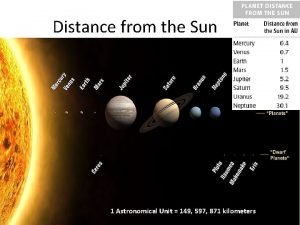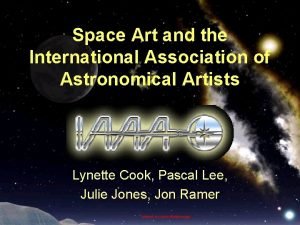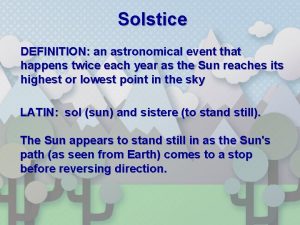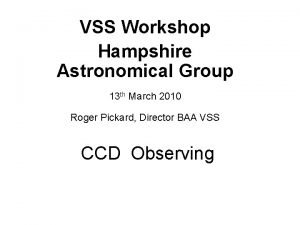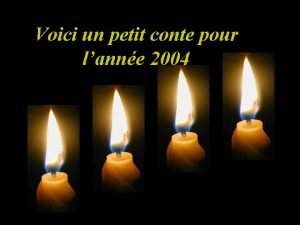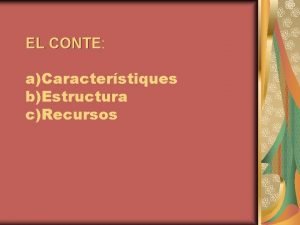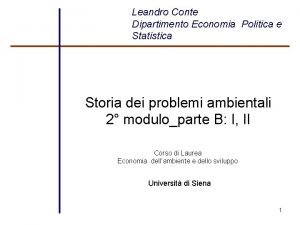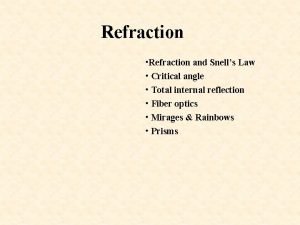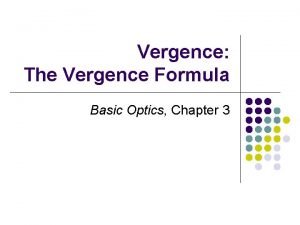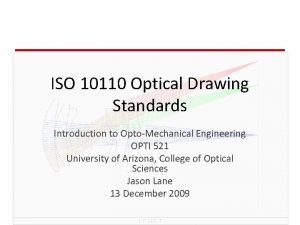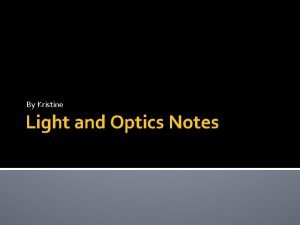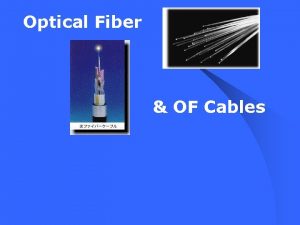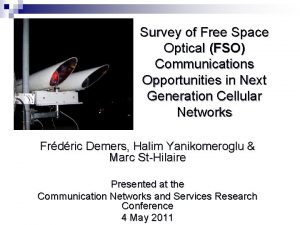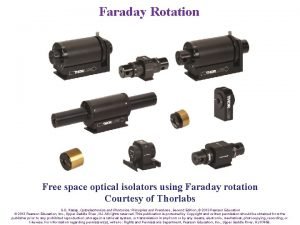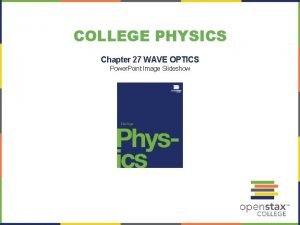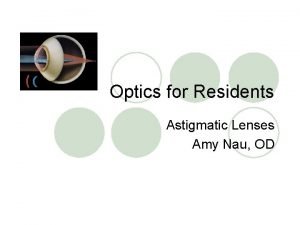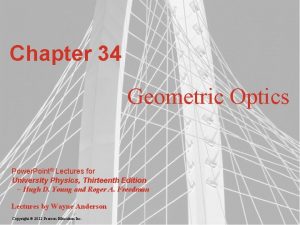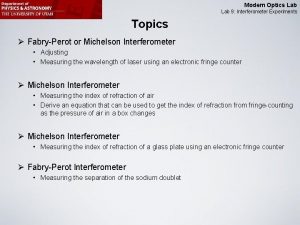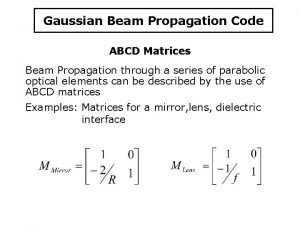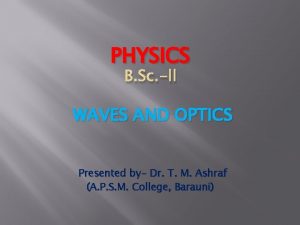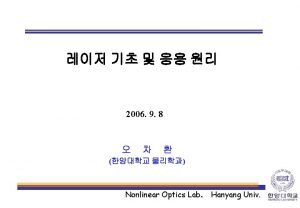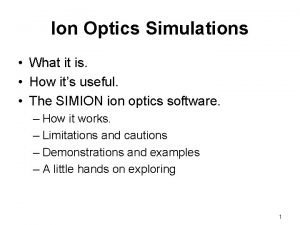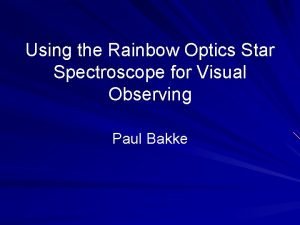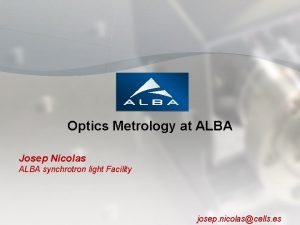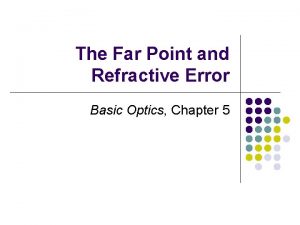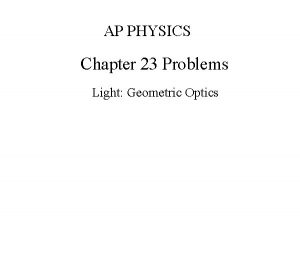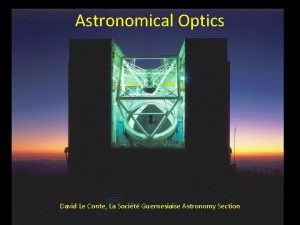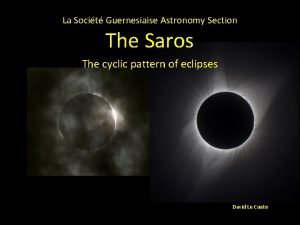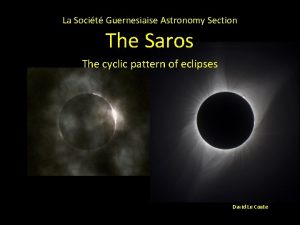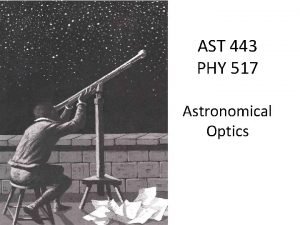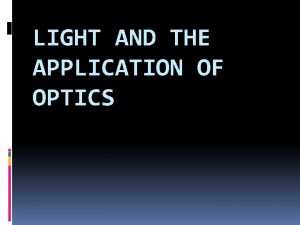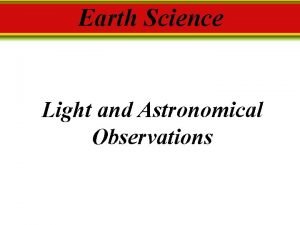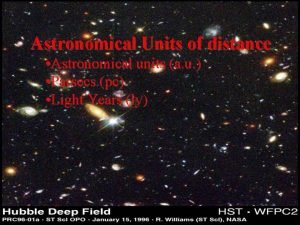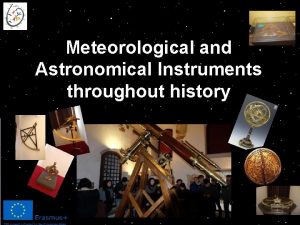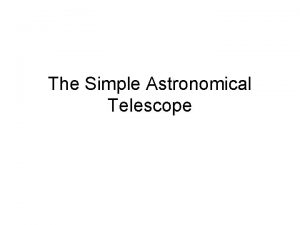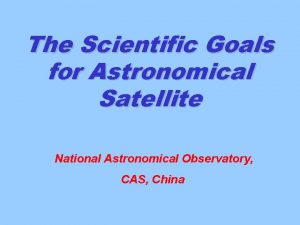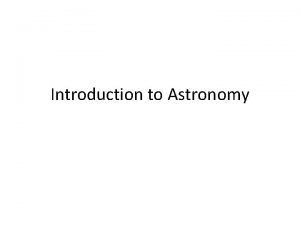Astronomical Optics David Le Conte La Socit Guernesiaise
































































- Slides: 64

Astronomical Optics David Le Conte, La Société Guernesiaise Astronomy Section

Astronomical Optics Telescope types Defects Corrections Mountings Telescope attributes Eyepiece characteristics Accessories Mirror types and manufacture Telescope set-up and maintenance Telescope use Detectors

Telescope types Binoculars Spotting scopes Refractor Reflector Newtonian Cassegrain Schmidt Catadioptric Schmidt-Cassegrain Maksutov Finder scopes Guide telescopes Heliostat / Coelostat / Siderostat Transit Zenith

Telescope types Refractor Cassegrain Newtonian reflector Coudé Schmidt-Cassegrain Catadioptric Maksutov

Binoculars Magnification x Aperture and field Roof-Prism Porro-Prism

Galileo Galilei (1564 -1642) – and his telescope. The first person to observe the night sky (and the Sun) with a telescope (1609).

A cheap refracting telescope

An expensive refracting telescope

40 -inch refractor at Yerkes Observatory (University of Chicago) The largest refractor ever built.

Sir Isaac Newton’s reflecting telescope (1668). The first reflecting telescope.

A modern Newtonian telescope

1. 2 m UK Schmidt telescope at Siding Spring Observatory, Australia

The Schmidt camera uses a spherical mirror and a corrector plate to correct for spherical aberration. It produces a curved image with a wide field. The Schmidt camera is used for imaging.

A spherical mirror has spherical aberration. Light rays do not focus to a single point. The corrector plate corrects for spherical aberration. It is an aspheric lens with spherical aberration equal to but opposite to the mirror.

Cutaway drawing of the 48 -inch Schmidt telescope at Mount Palomar, California

The Schmidt-Cassegrain telescope retains the corrector plate, but replaces the photographic film with a secondary mirror and a hole in the primary mirror. It is a combination of the Schmidt and Cassegrain systems.

6 -inch Schmidt camera 14 -inch Schmidt-Cassegrain telescope Eyepiece Fork mount Star diagonal Finder scope Equatorial wedge Pier (does not touch the floor)

With 6 -inch Schmidt camera

The Guernsey Observatory of La Société Guernesiaise has a 16 -inch Schmidt-Cassegrain and a 5 -inch refractor

4 -metre telescope, Kitt Peak National Observatory, Arizona Prime focus (Can hold two people) The person gives an idea of the telescope’s size Cassegrain focus

4 -metre telescope, Kitt Peak National Observatory, Arizona. Cassegrain focus. In the ‘Cassegrain cage’ which moves around with the telescope.

Usually large instruments are attached to the telescope. This is a spectroscope at the Cassegrain focus.

4 -metre telescope, Kitt Peak National Observatory, Arizona. Control room. Astronomers rarely look through such telescopes but use computers.

4 -metre telescope, Kitt Peak National Observatory, Arizona

4 -metre telescope, Kitt Peak National Observatory, Arizona. The telescope pier is separate from the building it is in so there is no vibration transmitted to the telescope.

Very large instruments can be installed at the Coudé focus. It uses a sequence of mirrors to send the light to a fixed location through the telescope’s axis.

Telescope mounts German Altazimuth Dobsonian Fork German


Eyepieces v Huyghenian (two plano-convex lenses, 17 th century, obsolete) v Ramsden (two plano-convex lenses, 18 th century) v Orthoscopic (triplet, 19 th century) v Kellner (three lenses, 19 th century) v Plössl (4+ elements, 19 th century, large field of view, short eye relief) v Nagler (up to 8 elements, 20 th century, ultra-wide field of view) v Erfle (5 elements, 20 th century, wide field, low-power, good eye relief) v Barlow (increases focal ratio, and therefore magnification) v Star diagonal (bends the light by 90⁰ to give a convenient viewing angle)

Eyepieces

Eyepiece characteristics v Barrel diameter – 2 in, 1. 25 in, 0. 965 in. v Field of view – Apparent size of the field stop. v Eye relief – Distance between rear lens and exit pupil. v Exit pupil – Focal length of eyepiece / focal ratio of telescope. Not more than 7 mm (diameter of dark adapted pupil).

Defects v Spherical aberration – Off-axis rays brought to different foci v Chromatic aberration – Different wavelengths brought to different foci v Coma – Fan-shaped images off-axis v Astigmatism – Focal length of one diameter different to another diameter v Temperature changes – Flexing of optical elements v Diffraction – Especially around obstructions v Airy disk – Disk-like image, surrounded by diffraction rings v Dawes limit – Maximum resolving power depends on aperture v Field rotation – With some mounts Corrections v Paraboloidal mirror v Field stop v Achromatic lens (2λ) v Large aperture v Apochromatic lens (3λ) v Altitude v Corrector plate

Telescope attributes Resolving power – The smallest angular separation distinguishable. Typically 1 arc-second, but can be hundredths of an arcsecond. Magnification – Focal length of telescope / focal length of eyepiece. Practical limit: 2 x aperture in mm. So a 100 mm aperture telescope has a practical maximum magnification of 200. Aperture – The diameter of the main optical element (ie objective lens or mirror) in inches or mm (or metres). Area – of the main optical element. A measure of light gathering power. So a 16 -inch telescope has over twice the light gathering power of an 11 -inch.

Magnifications produced by the Guernsey Observatory telescopes Telescope: Aperture (inches): (mm): Area (sq mm): Focal ratio: Focal length (mm): Eyepiece fl (mm) 50 40 32 26 24 16 12. 7 9 8 Takahashi 5 127 12, 668 8. 2 1040 21 26 32 40 43 65 82 116 130 Meade 16 406 129, 460 10 4064 Magnification 81 102 127 156 169 254 320 452 508 Celestron 11 280 61, 575 10 2800 56 70 87 108 117 175 220 311 350

Some accessories Laser pointers Solar filters Light pollution filters Nebula and other filters ‘Go. To’ telescopes Dew cap Mask (to reduce light entering the telescope) Bahtinov masks (for focusing) Software Apps

Laser pointer used to point out objects.

Laser pointer on telescope for aligning.

11 -inch Celestron telescope with a solar filter. Used to take this image of a solar eclipse.

La Societe Guernesiaise Astronomical Observatory 16 -inch telescope 5 -inch telescope Heliostat (Sun Telescope) 11 -inch telescope

Heliostat. A 6 -inch mirror tracks the Sun …

… and sends the light to a 6 -inch focusing mirror 70 feet away …

… which focuses the Sun’s image onto a screen

Mirror types and manufacture v Single-mirror v Segmented mirror v Fish-eye v Melting glass and rotation v Quarter-wave v Aluminising – front surface v Adaptive optics

Telescope set-up and maintenance v Polar alignment v Collimation v Cleaning v Aluminising

3 -metre mirror at Lick Observatory, Mount Hamilton, California

Aluminising 3 -metre mirror at Lick Observatory, Mount Hamilton, California

Aluminising 3 -metre mirror at Lick Observatory, Mount Hamilton, California

The Steward Laboratory of the University of Arizona produces very large lightweight mirrors by melting and spin-casting glass into a paraboloid shape.

Borosilicate glass is used because it has a relatively low coefficient of thermal expansion

Multiple mirror telescope, Whipple Observatory, Mount Hopkins, Arizona

Multiple mirror telescope converted to single mirror, Whipple Observatory, Arizona

Adaptive optics with the Gemini North telescope

Detectors v v v v Film cameras Digital cameras CCDs Webcams Spectroscopes Photometers Infra-red Micrometers

Film camera on Meade 16 -inch telescope

Webcam on Takahashi 5 -inch telescope

Webcam image of Moon, Takahashi 5 -inch telescope

CCD camera on Takahashi 5 -inch telescope

M 57 Ring nebula in Lyra M 17 Swan nebula in Sagittarius With CCD camera on 14 -inch Celestron telescope

10 metre gamma-ray telescope, Whipple Observatory, Arizona. Observes Cherenkov radiation produced by gamma rays entering the earth’s atmosphere.

Kitt Peak National Observatory, Arizona

Mc. Math-Pierce solar telescope, Kitt Peak National Observatory, Arizona. It is 500 feet long, 300 feet of which is inside the mountain!

The telescope uses a 1. 6 metre diameter mirror.

Mc. Math-Pierce solar telescope, Kitt Peak National Observatory, Arizona Dr Jack Harvey recording a partial solar eclipse at the Mc. Math-Pierce solar telescope, 12 October 1977.

This presentation has been brought to you by the Astronomy Section of La Société Guernesiaise, Guernsey, in the British Channel Islands. For more astronomical presentations go to: http: //www. astronomy. org. gg/more/resources/education
 Difference between ray optics and wave optics
Difference between ray optics and wave optics Reflection and refraction venn diagram
Reflection and refraction venn diagram Socit gnrale
Socit gnrale Socit
Socit Socit
Socit Socit
Socit Guildford astronomical society
Guildford astronomical society What is angular magnification
What is angular magnification Astronomical
Astronomical Astronomical time scale
Astronomical time scale Astronomical applications department
Astronomical applications department Astronomical coordinates
Astronomical coordinates Star testing astronomical telescopes
Star testing astronomical telescopes Astronomical clock lyon france
Astronomical clock lyon france Memphis astronomical society
Memphis astronomical society What is an astronomical unit
What is an astronomical unit International association of astronomical artists
International association of astronomical artists Astronomical event that occurs twice a year
Astronomical event that occurs twice a year Hampshire astronomical group
Hampshire astronomical group El valioso tiempo de los maduros mario andrade
El valioso tiempo de los maduros mario andrade Valeria conte tor vergata
Valeria conte tor vergata Les élément perturbateur dans un conte
Les élément perturbateur dans un conte Canto 20 inferno
Canto 20 inferno Conte des quatre bougies
Conte des quatre bougies Hino 63 as muitas bençãos
Hino 63 as muitas bençãos Caracteristiques d'un conte
Caracteristiques d'un conte Leandro conte
Leandro conte Le conte de la grenouille dans la marmite
Le conte de la grenouille dans la marmite La balena conte
La balena conte Canto inferno conte ugolino
Canto inferno conte ugolino Natalie conte
Natalie conte With the rule astigmatism
With the rule astigmatism Snells laws
Snells laws Vergence formula
Vergence formula Iso drawing standards
Iso drawing standards Grade 10 optics
Grade 10 optics Light and optics notes
Light and optics notes Disadvantage of fiber optic cable
Disadvantage of fiber optic cable Free space optics
Free space optics Disadvantages of optical fibre
Disadvantages of optical fibre Introduction to fiber optics
Introduction to fiber optics Free space optics
Free space optics Hotwire fiber optics
Hotwire fiber optics Superconducting devices in quantum optics
Superconducting devices in quantum optics Nonlinear optics
Nonlinear optics Optical power loss
Optical power loss Optics
Optics Maddox rod
Maddox rod Geometric optics ppt
Geometric optics ppt Modern optics experiment
Modern optics experiment A b c d
A b c d Wave optics b.sc physics
Wave optics b.sc physics The computational complexity of linear optics
The computational complexity of linear optics 368x5
368x5 Charging by induction
Charging by induction Nonlinear optics
Nonlinear optics Ion optics simulation
Ion optics simulation Rainbow optics star spectroscope
Rainbow optics star spectroscope Optics
Optics Far point of hyperopic eye
Far point of hyperopic eye Cauchy formula optics
Cauchy formula optics Dr hung nguyen
Dr hung nguyen The spencer optics company produces an inexpensive
The spencer optics company produces an inexpensive Geometric optics problems
Geometric optics problems Http //www.phys.hawaii.edu/ teb/optics/java/slitdiffr/
Http //www.phys.hawaii.edu/ teb/optics/java/slitdiffr/







